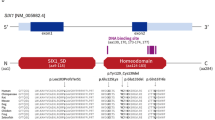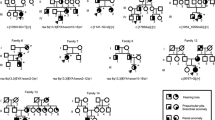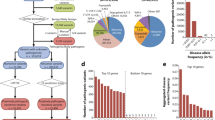Abstract
The branchio–oto–renal (BOR) syndrome is an autosomal-dominant disorder characterized by hearing loss, branchial and renal anomalies. BOR is genetically heterogeneous and caused by mutations in EYA1 (8q13.3), SIX1 (14q23.1), SIX5 (19q13.3) and in an unidentified gene on 1q31. We examined six Danish families with BOR syndrome by assessing linkage to BOR loci, by performing EYA1 multiplex ligation-dependent probe amplification (MLPA) analysis for deletions and duplications and by sequencing of EYA1, SIX1 and SIX5. We identified four EYA1 mutations (c.920delG, IVS10−1G>A, IVS12+4A>G and p.Y591X) and one SIX1 mutation (p.W122R), providing a molecular diagnosis in five out of the six families (83%). The present, yet preliminary, observation that renal and temporal bone malformations are less frequent in SIX1-related disease suggests a slightly different clinical profile compared to EYA1-related disease. Unidentified mutations impairing mRNA expression or further genetic heterogeneity may explain the lack of mutation finding in one family despite LOD score indications of EYA1 involvement.
Similar content being viewed by others
Log in or create a free account to read this content
Gain free access to this article, as well as selected content from this journal and more on nature.com
or
References
Melnick M, Bixler D, Silk K, Yune H, Nance WE : Autosomal dominant branchiootorenal dysplasia. Birth Defects Orig Artic Ser 1975; 11: 121–128.
Chen A, Francis M, Ni L et al: Phenotypic manifestations of branchio–oto–renal syndrome. Am J Med Genet 1995; 58: 365–370.
Chang EH, Menezes M, Meyer NC et al: Branchio–oto–renal syndrome: the mutation spectrum in EYA1 and its phenotypic consequences. Hum Mutat 2004; 23: 582–589.
Fraser FC, Sproule JR, Halal F : Frequency of the branchio–oto–renal (BOR) syndrome in children with profound hearing loss. Am J Med Genet 1980; 7: 341–349.
Kemperman MH, Koch SMP, Kumar S, Huygen PLM, Joostein FBM, Cremers CWRJ : Evidence of progression and fluctuation of hearing impairment in branchio–oto–renal syndrome. Int J Audiol 2004; 43: 523–532.
Ostri B, Johnsen T, Bergmann I : Temporal bone findings in a family with branchio–oto–renal syndrome (BOR). Clin Otolaryngol 1991; 16: 163–167.
Propst EJ, Blaser S, Gordon KA, Harrison RV, Papsin BC : Temporal bone findings on computed tomography imaging in branchio–oto–renal syndrome. Laryngoscope 2005; 115: 1855–1862.
Ceruti S, Stinckens C, Cremers CW, Casselman JW : Temporal bone anomalies in the branchio–oto–renal syndrome: detailed computed tomographic and magnetic resonance imaging findings. Otol Neurotol 2002; 23: 200–207.
Kemperman MH, Stinckens C, Kumar C, Joostein FBM, Huygen PLM, Cremers CWRJ : The branchio–oto–renal syndrome. In: Cremers CWRJ, Smith RJH (eds),: Genetic Hearing Impairment. Basel: Karger, Adv Otorhinol. 2002; 61: 192–200.
Ito T, Noguchi Y, Yashima T, Kitamura K : SIX1 mutation associated with enlargement of the vestibular aqueduct in a patient with branchio–oto syndrome. Laryngoscope 2006; 116: 796–799.
Kochhar A, Fischer SM, Kimberling WJ, Smith RJ : Branchio–oto–renal syndrome. Am J Med Genet A 2007; 143: 1671–1678.
Hereditary Hearing loss Homepage, http://webhost.ua.ac.be/hhh.
Kumar S, Deffenbacher K, Marres HAM, Cremers CWRJ, Kimberling WJ : Genomewide search and genetic localization of a second gene associated with autosomal dominant branchio–oto–renal syndrome: clinical and genetic implications. Am J Hum Genet 2000; 66: 1715–1720.
Hoskins BE, Cramer CH, Silvius D et al: Transcription factor SIX5 is mutated in patients with branchio–oto–renal syndrome. Am J Hum Genet 2007; 80: 800–804.
Vervoort VS, Smith RJ, O’Brien J et al: Genomic rearrangements of EYA1 account for a large fraction of families with BOR syndrome. Eur J Hum Genet 2002; 10: 757–766.
Web source (IOWA database) listing identified mutations in EYA1, http://www.medicine.uiowa.edu/pendredandbor/eya1Mutations.htm.
Ruf RG, Xu P-X, Silvius D et al: SIX1 mutations cause branchio–oto–renal syndrome by disruption of EYA1–SIX–DNA-complexes. Proc Natl Acad Sci USA 2004; 101: 8090–8095.
Rebay I, Silver SJ, Tootle TL : New vision from Eyes absent: transcription factors as enzymes. Trends Genet 2005; 21: 163–171.
Li X, Oghi KA, Zhang J et al: Eya protein phosphatase activity regulates Six1–Dach–Eya transcriptional effects in mammalian organogenesis. Nature 2003; 426: 247–254.
Ohto H, Kamada S, Tago K et al: Cooperation of Six and Eya in activation of their target genes through nuclear translocation of Eya. Mol Cell Biol 1999; 19: 6815–6824.
Gimsing S : The BOR syndrome as a possible neurocristopathy. Ear, Nose Throat J 1987; 66: 154–158.
Gimsing S, Dyrmose J : Branchio–oto–renal dysplasia in three families. Ann Otol Rhinol Laryngol 1986; 95: 421–426.
Rogan PK, Faux BM, Schneider TD : Information analysis of human splice site mutations. Hum Mutat 1998; 12: 153–171.
Nalla VK, Rogan PK : Automated splicing mutation analysis by information theory. Hum Mutat 2005; 25: 334–342.
Henriksen AM, Tümer Z, Tommerup N, Tranebjærg L, Larsen LA : Identification of a novel EYA1 splice-site mutation in a Danish branchio–oto–renal syndrome family. Genet Test 2004; 8: 404–406.
Expression-database, NCBI, Unigene, EST profile viewer, http://www.ncbi.nlm.nih.gov/entrez/query.fcgi?db=unigene.
Ott J : Analysis of Human Genetic Linkage. Baltimore and London: The John Hopkins University Press, 1999, pp 260–261.
Ruf RG, Berkman J, Wolf MTF et al: A gene locus for branchio–otic syndrome maps to chromosome 14q21.3-q24.3. J Med Genet 2003; 40: 515–519.
Salam AA, Häfner FM, Linder TE, Spillmann T, Schinzel AA, Leal SM : A novel locus (DFNA23) for prelingual autosomal dominant nonsyndromic hearing loss maps to 14q21-q22 in a Swiss German kindred. Am J Hum Genet 2000; 66: 1984–1988.
Stinckens C, Standaert L, Casselman JW et al: The presence of a widened vestibular aqueduct and progressive sensorineural hearing loss in the branchio–oto–renal syndrome. A family study. Int J Pediatr Otorhinol 2001; 59: 163–172.
Rickard S, Boxer M, Trompeter R, Bitner-Glindzicz M : Importance of clinical evaluation and molecular testing in the branchio–oto–renal (BOR) syndrome and overlapping phenotypes. J Med Genet 2000; 37: 623–627.
Lin X, Wells DE, Kimberling WJ, Kumar S : Human NDUFB9 gene: Genomic organization and a possible candidate gene associated with deafness disorder mapped to chromosome 8q13. Hum Hered 1999; 49: 75–80.
Okada M, Fujimaru R, Morimoto N et al: EYA1 and SIX1 gene mutations in Japanese patients with branchio–oto–renal (BOR) syndrome and related conditions. Pediatr Nephrol 2006; 21: 475–481.
Abdelhak S, Kalatzis V, Heilig R et al: Clustering of mutations responsible for branchio–oto–renal (BOR) syndrome in the eyes absent homologous (eysHR) of EYA1. Hum Mol Genet 1997; 6: 2247–2255.
Migliosi V, Flex E, Guida V et al: Identification of five novel BOR mutations in human EYA1 gene associated with branchio–oto–renal syndrome by a DHPLC-based assay. Clin Genet 2004; 66: 478–480.
Acknowledgements
We thank the families who participated in this study. In addition, we acknowledge the skilful guidance and technical assistance of Annemette Friis Mikkelsen, Lillian Egebjerg Rasmussen and Karen Friis Henriksen, and valuable technical help from Elvira Chapka and Marianne Lodahl at Department of Cellular and Molecular Medicine, ICMM, The Panum Institute. We also thank laboratory technician Anne-Lise Palle at the University Hospital, Rigshospitalet, Copenhagen, for performing the MLPA analysis, and Stephanie Fischer and Richard Smith, Department of Otolaryngology Head and Neck Surgery, University of Iowa Medical School, Iowa City, USA, for providing control samples for the MLPA analysis. The project was hosted by Wilhelm Johannsen Centre for Functional Genome Research, which is funded by the Danish National Research Foundation. The study was supported by the Oticon Foundation and Widex AS (NDR, LT and KMS).
Author information
Authors and Affiliations
Corresponding author
Additional information
Supplementary Information accompanies the paper on European Journal of Human Genetics website (http://www.nature.com/ejhg)
Rights and permissions
About this article
Cite this article
Sanggaard, K., Rendtorff, N., Kjaer, K. et al. Branchio–oto–renal syndrome: detection of EYA1 and SIX1 mutations in five out of six Danish families by combining linkage, MLPA and sequencing analyses. Eur J Hum Genet 15, 1121–1131 (2007). https://doi.org/10.1038/sj.ejhg.5201900
Received:
Revised:
Accepted:
Published:
Issue date:
DOI: https://doi.org/10.1038/sj.ejhg.5201900
Keywords
This article is cited by
-
Auricular fistula: a review of its clinical manifestations, genetics, and treatments
Journal of Molecular Medicine (2023)
-
Phenotype–genotype correlation in patients with typical and atypical branchio-oto-renal syndrome
Scientific Reports (2022)
-
A novel mutation in EYA1 in a Chinese family with Branchio-oto-renal syndrome
BMC Medical Genetics (2018)
-
Recurrent 8q13.2-13.3 microdeletions associated with Branchio-oto-renal syndrome are mediated by human endogenous retroviral (HERV) sequence blocks
BMC Medical Genetics (2014)
-
Identification of a novel nonsynonymous mutation of EYA1 disrupting splice site in a Korean patient with BOR syndrome
Molecular Biology Reports (2014)



